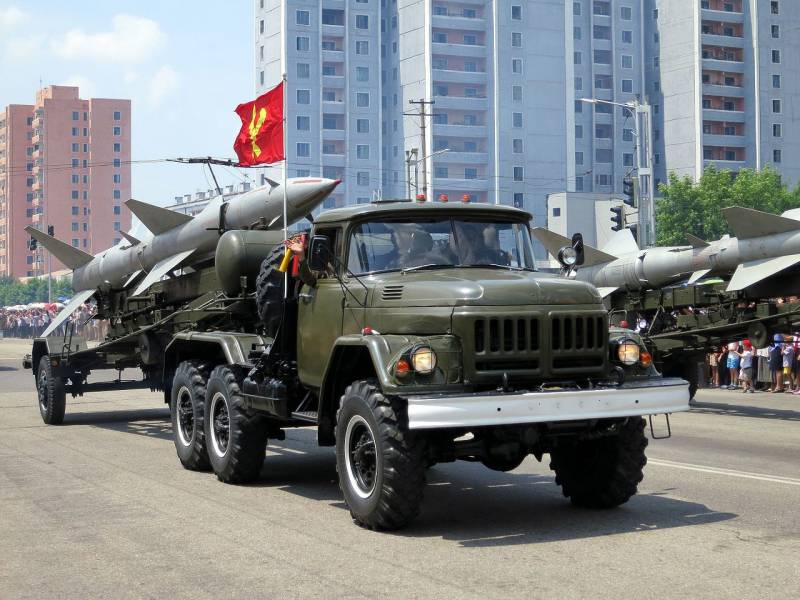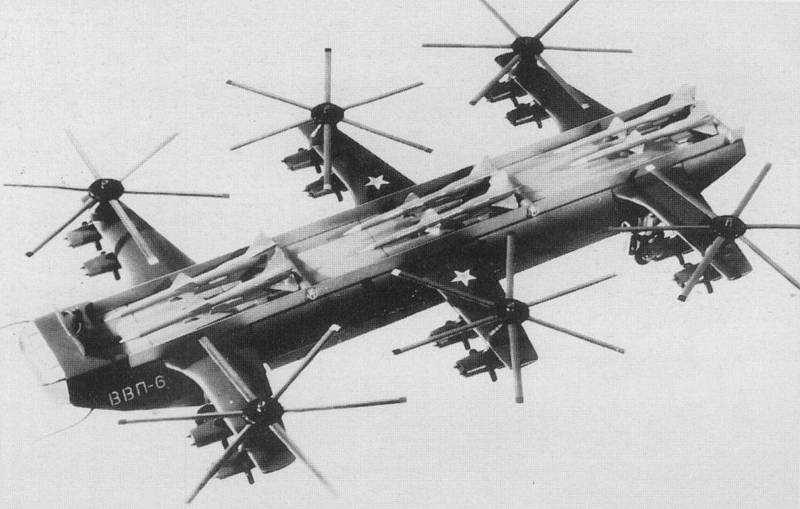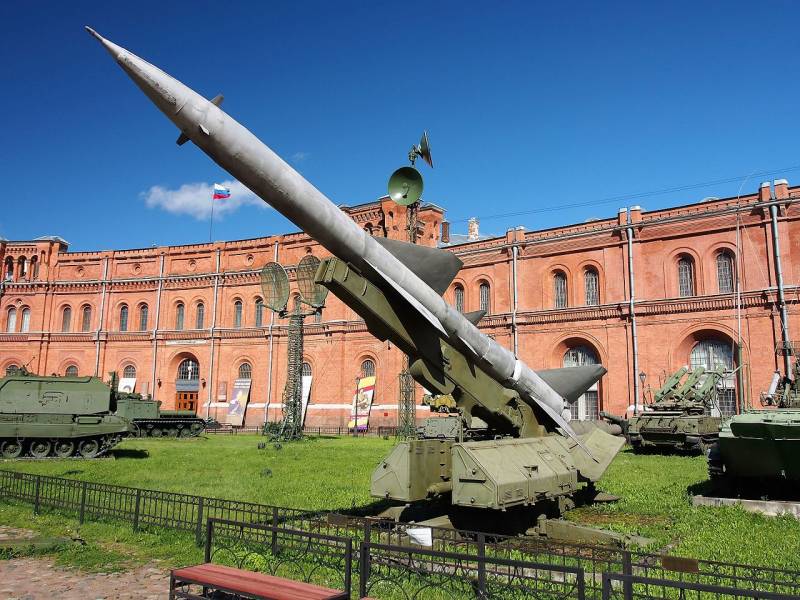Project GDP-6. Anti-aircraft missile helicopter for the Soviet Army
Unfortunately, not much is known about the GDP-6 project. In open sources there is only a brief description of it and a single photo of a large-scale layout. Nevertheless, this allows us to create an acceptable picture, as well as to evaluate the hypothetical possibilities of the proposed machine and understand why it was not even brought to the stage of technical design.
The GDP-6 project offered the construction of a heavy multi-rotor helicopter designed to carry a particular payload. Whereas other helicopters were meant to transport soldiers, weapons, ammunition and technology, the new model was supposed to take on board the missile anti-aircraft complex C-75 - and with the launchers. In essence, the original version of an anti-aircraft missile system on a rotary-wing platform was proposed, suitable for the rapid organization of air defense in a dangerous direction.
Specific tasks seriously affected the appearance of the helicopter. In terms of its architecture and layout, it should have been markedly different from other machines, both of its time and later. It was proposed to use the fuselage of a large cross section, able to accommodate a special payload. To obtain the desired load capacity, six independent propeller motor groups were used, located on six planes.
The basis of the airframe GDP-6 was the fuselage of an unusual form. The layout shows that it should have had a large elongation. Over most of the length, the same cross section was kept close to the rectangular one. In the forward part of the car was located the cockpit with the characteristic “balcony” of the lantern. Inside the fuselage could be fuel tanks and any load. In particular, the sources mention the possibility of placing additional ammunition within the vehicle.
From the point of view of aerodynamics, the glider GDP-6 made so-called. longitudinal triplane. In the nose, central and tail parts of the fuselage placed three wings. Each plane had a straight leading edge. Inside the wing and on its surface it was planned to place different units of the propeller group - one on each half wing. Perhaps, in horizontal flight, the wings should have created significant lift and partially unloaded the screws.
Apparently, it was planned to place the main rotor gearbox inside the wing. There were two pylons under the wing, on which the engineers placed two turboshaft engines each. What type of engine was proposed for use is unknown. On each wing there were four engines and a reducer that provided a six-blade propeller. The length of the main rotor blades was chosen so that the swept disc did not overlap the projection of the fuselage and did not threaten the payload.
Having six half wings with a propeller group on each, the GDP-6 helicopter should have six identical rotors at once. Their drive was carried out 24 individual engines, interconnected with special gears. As proposed to organize the management of the machine - is unknown. All screws could be equipped with skew automatons to change traction parameters. In addition, for maneuvering it was possible to use a differentiated change in engine speed.
Under the front and rear wings located retractable landing gear. Provided for the use of four pillars, two on each side. Probably in flight, they could get into the fuselage niche.
Not less than the GDP-6 helicopter itself is interesting in its payload. For its placement the upper part of the fuselage was made in the form of a flat rectangular platform with sides. On such a platform - in line with the wings - it was proposed to mount launchers for missiles. Between a pair of wing wings were placed two lifting rails with a rocket on each. Thus, an unusual-looking helicopter could carry and launch six C-75 SAM missiles. Provided for the use of missiles modifications B-750 and B-755.
Some sources claim that the target load of the GDP-6 could also include additional ammunition, a radar station and fire control devices. Unfortunately, the well-known photo of the layout does not allow to understand where and how all these products could be placed - in the first place, additional missiles and radar stations.
We can assume that the helicopter GDP-6 really could get all the necessary devices to turn into a full-fledged anti-aircraft battery. Otherwise, the radar detection and control, as well as other components of the complex would have to be placed on another platform. As a result, a full-fledged efficient anti-aircraft battery was supposed to consist of several GDP-6 with different equipment and different functions.
According to known data, the length of the promising helicopter on the fuselage was to reach 49 m. The width, taking into account the propeller disks, could be about half, the width of the fuselage is about 6 m. The calculated weight parameters of the helicopter are unknown. Depending on the model of the missiles used, the ready-to-use ammunition weighed 13-14 t. Additional B-750 / 755 missiles could almost double the total payload mass. Taking into account the level of weight perfection of helicopters of that time, it can be assumed that the maximum take-off weight of GDP-6 should have reached the level of 45-50 t. The flight performance is unclear.
The combat qualities of an air defense helicopter of type GDP-6 should have been directly dependent on its flight characteristics and the type of missiles used. The speed and range determined the possible lines of deployment of mobile air defense missile systems. Helicopters with missiles could in the minimum time arrive at a given position, perform landing and carry out the deployment of anti-aircraft weapons.
Depending on the type of installed missiles and the mode of operation of the guidance tools, the GDP-6 helicopter could hit aerodynamic targets at distances up to 20-25 or 40-45 km and altitudes from 3 to 30 km. To destroy the target, a high-explosive fragmentation warhead with a mass of 190 kg was used. The B-750 and B-755 missiles were equipped with a radio command control system.
Thus, in the shortest possible time on the way aviation an enemy anti-aircraft barrier could have been built using the most advanced S-75 missile system. After repelling the raid and destroying enemy aircraft, the GDP-6 helicopters had the opportunity to take off and leave the position in the shortest time, reducing the risks of a retaliatory strike.
***
The concept of an air defense helicopter armed with anti-aircraft missiles and equipped with the necessary control devices could be of interest to the military. The rotary-wing machine of the type of GDP-6 in theory gave the army special capabilities, and with them an advantage over the likely adversary.
The main advantage of GDP-6 was high mobility. In this regard, the helicopter with missiles was completely superior to all existing and promising SAM systems of the traditional appearance. It is not difficult to imagine how quickly the helicopter could reach the specified position and how far it could overtake the C-75 air defense system on standard vehicles. In terms of mobility, only fighters with air-to-air missiles could compare with a helicopter, but in this case there were also other differences.
At the cost of a reasonable increase in the size and weight of the helicopter, it was possible to obtain substantial ammunition, ready for use. In addition, there were opportunities to transport additional missiles. Thus, in terms of its fire qualities, the helicopter unit consisting of several machines turned out to be a substitute for a ground-based anti-aircraft battery.

The standard vehicle for transporting the C-75 was serial trucks. The photo shows the Korean People’s Army air defense system.
An important advantage of the GDP-6 project was unification with the existing ammunition air defense system. The project involved the use of B-750 and B-755 missiles, used by numerous C-75 complexes. Thus, the construction and deployment of a promising helicopter complex did not require the development and production of special missiles for it.
However, the original project had a number of problems of various kinds. Home - unnecessary complexity. The proposed machine was distinguished by its large size and weight, which required the use of 6 propeller groups with 24 engines - a kind of record among domestic development projects. Designing such a machine was extremely difficult technically and technologically. One can only guess how long it would take to create a technical project, and then build, test and bring an experienced helicopter.
There were also tactical problems. A mobile air defense missile system based on a helicopter, distinguished by high combat qualities, is sure to become a priority target for the enemy. Aviation and artillery were required to take all necessary measures to detect and destroy GDP-6 in flight or in position. At the same time, the enemy’s anti-aircraft systems could also be involved in suppressing helicopter air defense.
The dense packing of the rockets on the fuselage of the GDP-6 helicopter led to a characteristic problem. She did not allow the use of launchers with large angles of horizontal guidance. Because of this, there could be problems with pre-targeting and target acquisition. To rotate the rockets to relatively large angles, it was necessary to rotate the entire machine — not the simplest operation, requiring take-off. Transportation of the ammunition unit inside the fuselage confronted the designers with a new task. It was necessary to equip the helicopter with some built-in means of transferring missiles to launchers.
Thus, the proposed helicopter carrier for anti-aircraft missiles, GDP-6, had both specific advantages and significant drawbacks. Hypothetically, he could effectively solve his combat missions, but it turned out to be extremely difficult. As a result, the original project was considered unpromising from the point of view of real use. OKB A.S. Yakovlev did not receive an order for its further development, and the project went to the archive, where it was lost for several decades. In the future, such ideas were not returned. Even the progress in the field of anti-aircraft missiles, which reduced their size and mass, did not contribute to the emergence of anti-aircraft helicopter projects.
Of stories The project is a special heavy helicopter GDP-6 can draw several conclusions. Firstly, it shows that, based on well-known and well-developed solutions and components, an unusual concept can be constructed to solve common problems. In addition, the project confirmed that obtaining outstanding results is often associated with unnecessary complexity. As a result, the bold technical proposal was abandoned as unpromising. However, the GDP-6 project is worthy of a separate place in the history of domestic aviation.
Based on:
http://aviastar.org/
http://rbase.new-factoria.ru/
http://pvo.guns.ru/
Gunston B., Gordon Y. Yakovlev Aircraft Since 1924. UK: Putnam Aeronautical Books, 1997.
- Ryabov Kirill
- "Yakovlev Aircraft Since 1924", Wikimedia Commons


Information